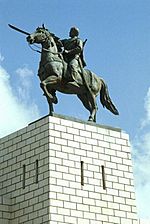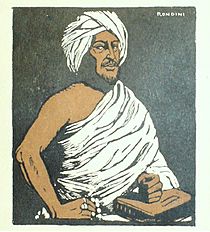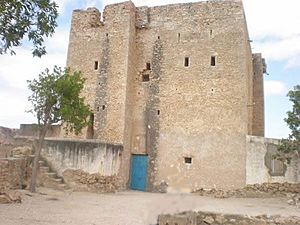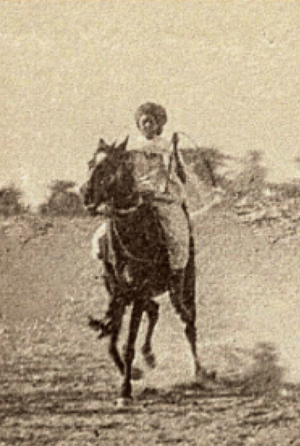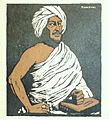Dervish movement (Somali) facts for kids
Quick facts for kids
Dervish Movement
Dhaqdhaqaaqa Daraawiish
|
|||||||||
|---|---|---|---|---|---|---|---|---|---|
| 1899–1920 | |||||||||
|
Flag of the Dervishes
|
|||||||||
| Capital | Nugal (1905–1909) Taleh (1913–1920) |
||||||||
| Common languages | Somali | ||||||||
| Demonym(s) | Somali | ||||||||
| Sayyid | |||||||||
|
• 1899–1920
|
Mohammed Abdullah Hassan | ||||||||
| History | |||||||||
|
• Established
|
1899 | ||||||||
|
• Battle of Jigjiga
|
1900 | ||||||||
|
• Signing of Ilig Treaty, Nugaal Valley is ceded to the Dervish
|
1905 | ||||||||
|
• Battle of Dul Madoba
|
1913 | ||||||||
|
• First World War (Support from the Ottoman Empire)
|
1914-1918 | ||||||||
|
• Decline of State
|
1919 | ||||||||
|
• Disestablished
|
9 February 1920 | ||||||||
|
|||||||||
| Today part of | Somalia Ethiopia |
||||||||
The Dervish Movement (Somali: Dhaqdhaqaaqa Daraawiish) was a group that fought for independence in the Horn of Africa. It was active between 1899 and 1920. The movement was led by Mohammed Abdullah Hassan, a poet and religious leader. He was also known as Sayyid Mohamed.
Hassan wanted to remove British and Italian control from the region. He also aimed to defeat Ethiopian forces. The Dervish movement sought to bring back a system of government based on Islamic teachings.
Hassan created a ruling council called the Khususi. It included wise Sufi elders and spokesmen. An adviser from the Ottoman Empire also joined. This helped create a movement that brought together different clans. This movement eventually helped shape the idea of the state of Somalia.
The Dervish movement grew quickly, attracting thousands of young people. They gathered weapons and attacked an Ethiopian army post in Jigjiga. This was their first military success. After this, the Dervishes declared the British colonial government their enemy. The British then worked with other Somali clans. They gave these clans weapons to fight the Dervishes.
The Dervishes faced some losses but learned to fight using guerrilla warfare. In 1905, Hassan signed a treaty with the Italians. This treaty gave the Dervishes control of the Nugaal Valley. This made their movement stronger. By 1908, the Dervishes were back in British Somaliland. They caused major problems for the British. The British eventually pulled back to the coast. This left the inner regions of the Horn of Africa in Dervish hands.
The First World War shifted Britain's focus. But after the war ended in 1920, the British launched a huge attack. They used air power and ground forces against the Dervish strongholds in Taleh. Many Dervishes were hurt or killed. However, Mohammed Abdullah Hassan managed to escape. He died in 1921 from illness, which ended the Dervish movement.
The Dervish movement created a temporary "proto-state" in Somalia. This was a mobile state with changing borders. It was one of the longest and bloodiest resistance movements in Africa during colonial times. The fighting over two decades caused many deaths. It also damaged the local economy.
Contents
History
How the Movement Started
Traditional Somali society was organized differently from European countries. People lived a nomadic life, relying on their animals. They were mostly Muslim. When European powers came to the Horn of Africa, Somalia came under British, Italian, and Ethiopian influence.
Foreign rule changed the economy. It made it harder for Somalis to live their traditional way of life. The foreign powers were also Christian. This made many Somalis, especially religious leaders, suspicious. Ethiopian troops were also known for raiding Somali herds. The arrival of colonial powers and the division of Africa greatly affected Somalis. Poets like Faarax Nuur wrote poems against foreign rule. The Dervish movement began as a response to this foreign control.
The Dervish movement was led by Mohammed Abdullah Hassan. He was a Sufi poet and religious leader. He was born in Sacmadeeqo between 1856 and 1864. His father was a religious teacher. Hassan studied in Islamic schools in Somalia. He later traveled to Mecca for Hajj. There, he met Shaykh Muhammad Salah, a leader of the Salihiya Tariqa. This was a strict Sufi group.
When Hassan returned to the Horn of Africa, he saw Christian missionaries converting Somali children. Hassan began speaking out against this. He also spoke against the British presence. The British colonial government called him the 'mad mullah'. Other Sufi groups also disagreed with his teachings.
Another story says that in 1899, Hassan bought a gun illegally. The British demanded the gun back. Hassan replied that the British should leave the country. He had already said in 1897 that he was "the leader of a sovereign nation." Hassan kept speaking against the British. He said they were destroying their Islamic religion.
Hassan left the cities and preached in the countryside. Many elders and young people became his followers. Hassan brought these young people from different clans together. He formed them into a Muslim group. They aimed to protect Islam from Christian missionaries. This group became Hassan's armed resistance. They were known as Dervishes or Daraawiish.
The Movement's Actions

The Dervish movement created a temporary Somali "proto-state." This was a mobile state with changing borders. This was because the Dervishes used guerrilla tactics. They would retreat to remote areas when stronger colonial forces attacked them.
Mohammed Abdullah Hassan was the leader of this state. He made the final decisions. He had a group of commanders for military actions. These were supported by the khusuusi, or the Dervish council. Islamic judges settled disagreements and enforced Islamic law. Two of Hassan's main advisers were Sultan Nur and Haji Sudi Shabeel. Haji Sudi was fluent in English.
From 1900 to 1913, the Dervishes operated from temporary centers. These included Aynabo and Illig.
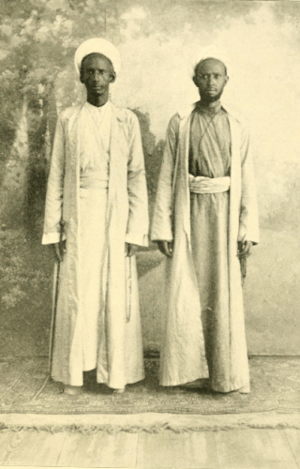
Dervish soldiers wore white turbans. Their army used horses for quick movement. They sometimes killed clan leaders who opposed them. Dervish soldiers used traditional dance-songs like dhaanto and geeraar to boost their spirits. Hassan led his soldiers strictly. He made sure they were deeply religious and ready for battle. He wanted them to be united as Dervishes, not by their different tribes.
The movement got firearms from the Majerteen Sultanate. They also received weapons from the Ottoman Empire and Sudan. The Dervishes fought many battles against Ethiopian troops starting in 1899. In 1904, they suffered a big defeat in Jidbaley. Hassan retreated to Italian Somaliland. He made a treaty with the Italians. This treaty gave the Dervishes control of the port of Eyl. This port became their headquarters from 1905 to 1909. During this time, Hassan rebuilt the Dervish army. They raided neighboring clans. In 1909, they killed a rival Sufi leader, Uways al-Barawi.
In 1913, after the British pulled back to the coast, the Dervishes built a walled town. This town, Taleh, had fourteen fortresses. They brought skilled builders from Yemen. This became their main headquarters. The main fortress, Silsilat, had special granaries and wells. It also had a guard tower and tombs. It was where Mohammed Abdullah Hassan lived with his family. The town of Taleh was mostly destroyed by British air attacks in 1920. However, Hassan had already left by then.
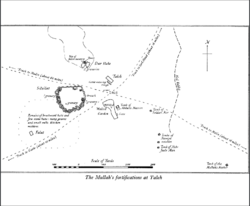
The Dervish movement wanted to remove British and Italian influence. They aimed to bring back an Islamic system of government. This system would have Islamic education as its main foundation.
Wars Against Colonial Powers
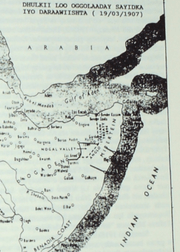
In August 1898, the Dervish army took control of Burao. This was an important center in British Somaliland. This gave Muhammad Abdullah Hassan control over the city's water sources. Hassan also helped local clans make peace. He called a large meeting where people were urged to join the war against the British. His forces wore simple white uniforms and turbans. They carried prayer beads and rifles.
In March 1900, Hassan and his Dervish forces attacked an Ethiopian outpost near Jijiga. The Dervishes continued to raid despite losses. By June 1900, Hassan had become even stronger. He controlled much of the southern part of the British Protectorate.
The British government began working with the Italians and Ethiopians. By 1901, they planned to stop the Dervish movement. It was hard for the British and their allies to fight in the vast, dry land. They lacked supplies and fresh water. Even with better weapons, like machine guns, the Anglo-Ethiopian forces struggled. Hassan was hard to catch. Finally, the British decided to use aircraft against the Dervish movement. This was a new way of fighting for them.
In the Somaliland campaign of 1920, 12 Airco DH.9A aircraft were used. They supported the British ground forces. Within a month, the British took over the Dervish capital. Hassan retreated to the west.
End of the Movement
Korahe Raid
In the early 1900s, the British and Abyssinians agreed to stop camel raids between Somali tribes. If a tribe raided, their government would punish them. However, the Abyssinians did not fully control the Haud region. This meant the Dervish and Ogaden alliance could raid freely. Meanwhile, the Isaaq and Dhulbahante tribes could not get revenge. The British Somaliland Camel Corps stopped them and returned stolen Ogaden animals.
The British administrator, Douglas James Jardine, noted that the Isaaq clans were stronger than the Ogaden. After many Dervish-Ogaden raids, tribal elders spoke with the British. They convinced the British to let the clans fight the Dervish-Ogaden themselves. The leader chosen for this was Akil (tribal chief) Haji Mohammad Bullaleh, also known as Haji Warabe. He had his own disagreements with the Mullah.
After the bombing campaign of the Taleh fort, the Dervishes retreated into Ogaden territory in Abyssinia. The Mullah gained more followers from his tribe there. The main event that led to the Hagoogane raid happened on May 20, 1920. A Dervish-Ogaden force attacked the Ba Hawadle sub-clan of the Ogaden. This clan was under Isaaq protection. Women and children were killed in the attack.
Haji Warabe gathered an army of 3000 warriors. These were from the Habr Yunis, Habr Je'lo, and Dhulbahante tribes. On July 20, 1920, Haji's army reached Korahe. This was where the Dervish and their allies were camped. They attacked with great force. The Dervish-Ogaden, numbering 800, were quickly defeated. Only about 100 survived and fled south. Haji and his army took 60,000 animals and 700 rifles. During the battle, Haji Warabe went to the Mullah's tent. But he found it empty, with the Mullah's tea still warm. The Mullah had fled to Imi. He died there shortly after from influenza.
Legacy
The Dervish movement has had a big impact on Somalia and Somaliland. It is seen as one of the most important Islamic movements in Somalia's history. The movement and its leader have been viewed differently by Somalis. Some see it as the start of modern Somali nationalism. Others believe it was a militant group that stopped Somalia from modernizing. They think it favored a strict Islamic state.
Hassan and his Dervish movement have inspired national pride in Somalia today. The military government of Somalia, led by Mohamed Siad Barre, built statues in Mogadishu. These statues honored three important Somali historical figures. They included Mohammed Abdullah Hassan of the Dervish movement. The castles and forts built by the Dervishes are now considered national treasures of Somalia.
The Dervish period also produced many poets. These poets were involved in a struggle known as the Literary war. This war greatly influenced Somali poetry and literature. Mohammed Abdullah Hassan was the most famous poet of that time. Many of these poems are still taught in Somali schools. They are also recited by Presidents of Somalia and in poetry competitions. In Somali Studies, the Dervish period is an important part of Somalia's history. It shows how the resistance movement was inspired by European control.
Modern Legacy
The Puntland Dervish Force is named in honor of the Dervishes.
Images for kids
-
'The Mullah's fortifications at Taleh'. The tombs of Mohammed Abdullah Hassan, Sultan Nur and unnamed Habr Je'lo and Hawiye notabales can be seen in the Dhulbahante garesa.
-
Territory of Darawiish sultan Diiriye Guure in 1907 (marked out in black ink delineation), according to Somali historian Muxamed Ibraahim Muxamed.



